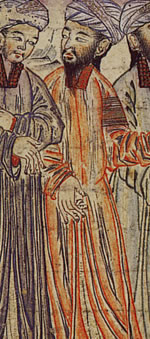Death of Musa (Moses)
Jami‘ al-tavarikh (Compendium of Chronicles)
Iran (Tabriz), A.H. 714/A.D. 1314–15
Ink, colors, and gold on paper
The Nasser D. Khalili Collection of Islamic Art, London (MSS 727,
folio 294b)
Cat. 7
© Nour Foundation
|
 |
 |
Jami' al-tavarikh (Compendium of Chronicles)
Ghazan (reigned 1295-1304), the seventh ruler of the Ilkhanid dynasty
and the first to convert to Islam, commissioned his vizier, Rashid
al-Din (1247-1318), to write the history of the Mongols. During
the reign of Ghazan's brother and successor, Öljeitü (reigned 1304-16),
this text-known as Jami' al-tavarikh, or Compendium of
Chronicles-developed into the earliest account of world history.
The pages from the Arabic version here come from the earliest-known
copy of this chronicle, completed in 1314-15 and made under the
author's supervision.
This manuscript initially comprised four volumes. Only the second
half of the second volume survives, narrating the history of the
ancient Iranian and Arabian kings, the prophet Muhammad and the
caliphs, the Jews, the noncaliphal rulers of Iran and Asia Minor,
the Franks, the Indians, and the Chinese. The Edinburgh University
Library and Nasser D. Khalili Collection manuscripts make up this
section of the second volume.
The two contain more than 200 folios, with 110 illustrations and
80 portraits of Chinese emperors and their attendants. The paintings
draw upon a wide range of sources including pre-Mongol Persian and
Arabic texts, Chinese scrolls and woodblock illustrations, Byzantine
manuscripts, and Crusader painting in the French Gothic style. Perhaps
most significantly, in the illustrations from this section of the
Compendium of Chronicles, the non-Mongols are recast with the characteristic
features and costumes of Mongols, thereby in a sense uniting all
of world history with that of the Mongols.
A scene from the Jami' al-tavarikh's history of the Jews,
the illustration of Musa's death is, like the other paintings in
this manuscript, composed from a pastiche of stylistic and iconographic
influences. |
|

 |


